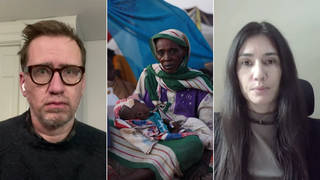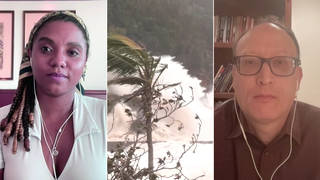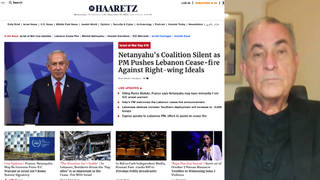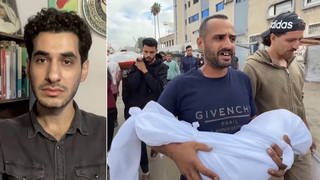
Guests
- Maya GebeilyReuters bureau chief for Lebanon, Syria and Jordan.
Links
- "Israeli tank fire killed Reuters journalist Issam Abdallah in Lebanon"
- HRW: "Israel: Strikes on Journalists in Lebanon Apparently Deliberate"
- Amnesty International: "Lebanon: Deadly Israeli attack on journalists must be investigated as a war crime"
- AFP probe into October strike on journalists in Lebanon points to Israeli army
Human Rights Watch and Amnesty International are calling for Israel to be officially investigated for committing war crimes in its targeting of journalists. This comes after an internal Reuters investigation conclusively found that its journalist Issam Abdallah was killed by an Israeli tank shell fired on him and a group of six other journalists in southern Lebanon on October 13. We speak with investigation co-author and Reuters Lebanon bureau chief Maya Gebeily, who says the group of journalists “did everything right,” including being clearly marked as press, yet were still fired upon in two successive strikes, meaning the attack is a clear violation of international humanitarian law against the military targeting of journalists.
Transcript
AMY GOODMAN: Human Rights Watch and Amnesty International are calling for Israel to be investigated for committing war crimes for targeting journalists. The groups have both called for an official investigation into an October 13th Israeli tank strike that killed Reuters journalist Issam Abdallah while he was reporting in southern Lebanon with a group of six other journalists. One of the journalists who survived the attack, Christina Assi of Agence France-Presse, AFP, had to have her leg amputated. She’s still hospitalized. Human Rights Watch said it, quote, “found no evidence of a military target near the journalists’ location,” unquote. Reuters also conducted its own investigation and concluded that Issam Abdallah was killed by an Israeli tank shell.
This is an excerpt of a short video report produced by Agence France-Presse. It includes interviews with AFP reporters Christina Assi, in her hospital bed, and Dylan Collins.
ALESSANDRA GALLONI: Reuters video journalist Issam Abdallah was killed on Friday, October 13th, when a shell hit him.
NARRATOR: Six other journalists are wounded. Among them, AFP photographer Christina Assi, who suffers serious injuries, later needing an amputation of her right leg.
CHRISTINA ASSI: Everything gets white, and I lose sensation in my leg.
DYLAN COLLINS: I saw Christina on the ground, and I immediately ran to her, and we were hit the second time.
CHRISTINA ASSI: There was no Hamas around us, no Hezbollah around us.
DYLAN COLLINS: Seven journalists wearing flak jackets, wearing helmets, everyone with “press” written on their chest, there’s no way they didn’t know that we were press.
CHRISTINA ASSI: And we were attacked by Israel twice, not once.
AMY GOODMAN: That was AFP reporter Christina Assi, who lost her leg after being hit by an Israeli tank shell October 13th in the same attack that killed Reuters journalist Issam Abdallah. And this is an excerpt from a video made by Amnesty International documenting how it determined that Issam Abdallah was killed by an Israeli tank shell.
MARIJA RISTIC: In many cases when we work on conflicts, the weapon can directly lead us to perpetrators. This is the key piece of evidence. My colleague, who’s our weapons analyst, knew immediately what this weapon is.
AYA MAJZOUB: It was a 120-millimeter tank round. And that confirmed that it was the Israeli military that fired on the journalists, because Hezbollah and the armed groups in south Lebanon don’t use those kinds of weapons.
MARIJA RISTIC: And more importantly, we did identify this weapon before being used by the Israeli forces in the context of different strikes on Gaza. So this is at least the third time where we are able to link this type of weapon with the Israeli forces.
AMY GOODMAN: An excerpt of a video by Amnesty International.
We’re joined now by Maya Gebeily. She is the Reuters bureau chief for Lebanon. She co-wrote the new Reuters special report, “Israeli tank fire killed Reuters journalist Issam Abdallah in Lebanon.”
Maya, welcome to Democracy Now! Our condolences to you and your colleagues on the loss of Issam. If you can talk about what exactly you found? Talk about that day, as we just heard these other reporters who survived the attack, one having lost her leg, discussing.
MAYA GEBEILY: Thank you, Amy, for having us on. And, of course, Issam’s loss is one that we continue to feel every single day in the Reuters bureau and across the media, the media teams across Lebanon.
That day, I mean, ironically and very sadly, it was Friday the 13th. And Issam had been in the south covering Israeli shelling on Lebanese territory for a few days by that point. And he’s a very seasoned journalist. So, as you have reported yourself, as well, on this show in the past, Issam had a lot of conflict experience. He did everything right, along with the colleagues with whom he was, on that day. They were wearing press helmets. They were wearing vests that had “press” written on them. They were in an open area in which they could be clearly identified by all of the, obviously, the Israeli drone activity above, the Israeli helicopter activity around them, that they could be clearly identified as press.
And that evening — it was really as the sun was setting — that team of journalists — there were seven of them there in total on that hilltop — were hit twice, 37 seconds apart, first by an Israeli tank shell that hit Issam and killed Issam immediately, and 37 seconds later by another tank shell that hit the vehicle that had been driven by the two Al Jazeera journalists that were also going live from that location. And really, it was the experts that we spoke to at the end of our investigation, after presenting them with the evidence that we had gathered, you know, noting that there were two strikes in such quick succession at a team of journalists that could be so clearly identified, that warrants, you know, calling this a violation of international humanitarian law and possibly amounting to a war crime.
AMY GOODMAN: So, talk about this. I mean, you’ve got Al Jazeera. You’ve got AFP, Agence France-Presse. You’ve got Reuters. Issam had just set up, what, like an hour before, this live feed, that people all over the world were watching. I talked to another Reuters journalist who said he was watching, and suddenly just this strike, trying to figure out what had taken place. So, in a sense, he actually filmed his own death, Issam.
MAYA GEBEILY: Yes. And I think that is the ultimate kind of — you know, he was really bearing witness everything that was happening in southern Lebanon. And Issam himself is from southern Lebanon. So, you know, it is such a testament to the power of his work and of his job that really it was him and the feeds of other journalists that were there in the area that provided such an important piece of evidence for us as we were investigating exactly what happened. I mean, in the immediate aftermath, you know, we were gathering the footage from different journalists who were there. We were also gathering what Issam had filmed himself on his camera and on his phone. And it was so difficult to go through that, that evidence, knowing that he had really documented such important evidence of what had taken place that day.
AMY GOODMAN: And can you talk about the tank shell — the two tank shells that injured and killed the journalists, and how you were able to identify them? We just heard clips from Amnesty and AFP.
MAYA GEBEILY: Absolutely.
AMY GOODMAN: And how precise they were, as opposed to a dumb bomb that’s being used, for example, in Gaza in almost half the cases?
MAYA GEBEILY: Absolutely. So, what we did in the immediate aftermath — the attack was on a Friday. By Sunday, we were trying to gain access to the site where Issam was killed. There was ongoing shelling in the area, so it was very difficult for us to be able to go in and to collect evidence, but we were able to get to the site and to spend a few minutes there, essentially just picking up what we thought could be shrapnel, so that we could get it tested. We, later on, then also obtained another — the tail fin, which is the biggest piece of evidence that we had. And these were taken to a lab in The Hague. We had other analysts looking at them at the same time visually and being able to kind of identify the features of these different bits of shrapnel visually to tell us what they think it might be. The lab was able to test them from a chemical perspective, to test, you know, what chemical components were there.
And these independent analytical processes came to the same conclusion, which is that this is an Israeli-made tank, as you noted in the introduction, as well. It’s made by an Israeli weapons manufacturer. And it is fired from a weapon system that’s on top of the Merkava tank. And so that was really the conclusive kind of evidence, in addition to geolocation of the exact firing location from where these shells were fired, that could allow us to conclusively say that this was an Israeli tank using an Israeli weapon system, fired from an Israeli location, that hit those journalists on that day.
AMY GOODMAN: And what about the drones? One of the things the reporters described — well, they say there wasn’t gunfire; they weren’t, like, caught in the crossfire at that point; it was quiet — that there were drones. They were all wearing their press gear. You know, you could see “P-R-E-S-S.” They said I’m sure that they could see their faces that closely. Talk about the level of Israeli surveillance there.
MAYA GEBEILY: It’s a really important point, and not one that should be overlooked. Again, these journalists did everything right. In the interviews that we conducted, as well, with our own teams that were there — Thaer Al-Sudani, Reuters photographer; Maher Nazeh, Reuters video journalist, who were also wounded on that day — they said, “We chose that location specifically — not just because we had a clear view of the border area which we wanted to be filming, but also because there were different positions along the border that had a clear view of us. And so nobody could then accuse us of embedding with armed groups, doing something suspicious, you know, hiding behind a line of trees, anything like that. We were clearly visible from all sides.” And that was one of the key reasons they chose that location. So, that’s the kind of 360 on the ground.
But in all of the footage that we reviewed and in the eyewitness statements that we gathered, as well, from that day, everybody — everybody — could mention and remembered hearing the sound of Israeli drones, surveillance drones, overhead. That sound really has not left southern Lebanon over the past two months almost. There have been brief respites, but the residents of southern Lebanon are very, very accustomed to hearing that sound, hearing the sound of surveillance drones above. And so, what that tells us is, again, Israel had such a clear view of the journalists, either from the air or from the different surveillance points that they have along the border. And, you know, Merkava tanks, as well, have a very, very — have a very long distance at which they can see quite clearly through the scope. I believe it’s up to nine kilometers, if I’m not mistaken. But either way, those journalists were about 1.3 kilometers from the border. They were clearly within the visible range that you could have from that scope.
AMY GOODMAN: They had such a view of the area in three directions. I mean, this is a controversial question. Do you think Israel did not want them there? And what have they said? I mean, right afterwards, when there was tremendous outcry, they said they would look into it. They said they were sorry it happened. They didn’t take responsibility. What about now that the Reuters report is out, the Amnesty report is out, the Agence France-Presse report is out?
MAYA GEBEILY: We, at various points, Reuters, from the very first moment, you know, from that night of Friday, October 13th, sought more details and more information from the Israeli military. So, at various points, Reuters has gone back to the Israeli military and asked them, “Can you give us more information about what happened on that day? Can you tell us whether it was you that targeted them? If so, what were they suspected of doing, or what was the reasoning?” And we’ve gotten very little information. I mean, the IDF has told us, just in response to our findings, that they do not target journalists. And we have gotten nowhere else beyond that.
I mean, they have repeatedly said, obviously, when it comes to southern Lebanon, that this is a conflict area, that there is kind of crossfire happening all the time, that it’s very dangerous. But I think it’s really important to remember, again, that these journalists were not embedded with any armed actors. They were there on that hilltop, very, very far away, as Amnesty has really kind of meticulously laid out in its report, as well, and as the eyewitnesses told us, very far away from any armed activities and from any crossfire. It’s not like they were caught up between two sides shooting at each other. It was a very quiet day, and they were filming shelling at a distance.
And it’s important to note here, as well, that after our investigation was published, Reuters editor-in-chief Alessandra Galloni has escalated her calls to Israel, not just to carry out an investigation, but to carry out a criminal investigation and to determine who exactly was responsible for those two strikes. And, you know, that really goes to show that there’s something criminal that took place on that day.
AMY GOODMAN: According to the Committee to Protect Journalists, 63 journalists and media workers have been killed since October 7th, including 56 Palestinian, four Israeli and three Lebanese journalists. Authorities in Gaza put the death toll higher, saying 86 Palestinian media workers have been killed in Gaza since October 7th, the Hamas attack. The Committee to Protect Journalists says no other war has taken so many journalist lives in such a short time span, this according to CPJ data that’s been gathered since 1992. Your final comments? And as we wrap up, Maya, you didn’t just do an investigation of people you didn’t know. You knew Issam Abdallah well. This is a close-knit community. And it goes beyond Reuters, journalists dealing with this all over the world, how many journalists are dying right now in Gaza and southern Lebanon. What do you want us to remember about Issam?
MAYA GEBEILY: Issam was someone who did everything with a lot of passion and integrity. And as we were carrying out this investigation, you know, I was trying to do it in the same way, just to carry — you know, to leave no stone unturned, to do this as right as we possibly could and go as far as we possibly can with that investigation. And even journalists within Reuters who never met Issam were so moved by learning about him as they worked on this investigation, in the way that he did his job, the care with which he approached every interview subject. He treated everybody with so much humanity and with so much love. He was really a model for us in the Beirut bureau, for people who had been journalists even for longer than him and for people who were just starting out. He just took the time to teach everyone, to teach our interns, to teach everybody who was in the office how to look for a story, how to do a story justice. And I think that’s something that — you know, we’re all trying to carry that with us every single day as we try to pick up the pieces in the office and keep covering what is continuing to be, you know, a very active and bloody conflict around the region.
AMY GOODMAN: I encourage people to go to our interview with Lama Al-Arian, who was a dear friend of Issam in Lebanon. She works with Vice News. Maya Gebeily, we want to thank you so much for being with us, Reuters bureau chief for Lebanon, co-wrote the new Reuters special report, “Israeli tank fire killed Reuters journalist Issam Abdallah in Lebanon.”
Coming up, investigative journalist Jeremy Scahill of The Intercept on what he describes as the joint U.S.-Israel military operation in Gaza. And then we’ll speak with one of the three Palestinian students, this one who attends Haverford College, and talk about what’s happening on campus and that night, Thanksgiving, when he and his two dear friends from Ramallah were shot in Vermont. Stay with us.












Media Options